Introduction
The renewable energy sector is witnessing an unparalleled expansion, fueled by the global push towards sustainable energy solutions. In 2023, the industry saw a historic rise in job opportunities, reaching 16.2 million positions globally, a significant increase from the previous year's 13.7 million. This 18% growth highlights the rapid advancements in renewable energy capacities and equipment manufacturing.
Key players in this burgeoning job market include land acquisition professionals, whose expertise in securing essential sites is critical for the success of renewable energy projects.
Geographical disparities are evident, with China accounting for nearly two-thirds of new solar and wind installations and leading the world with 7.4 million renewable energy jobs. The surge in employment is driven by clean energy technologies, including solar photovoltaics, wind, electric vehicles (EVs), batteries, and critical minerals mining, despite facing a notable shortage of skilled labor.
Public policies and significant investments have been pivotal in supporting this growth. Legislation such as the Infrastructure Investment and Jobs Act and the Inflation Reduction Act has catalyzed both public and private sector investments, particularly in solar, wind, and hydrogen projects. These developments underscore the crucial need for a skilled and diverse workforce to sustain the momentum of renewable energy expansion.
As the sector grows, the role of land acquisition professionals becomes increasingly vital. Their ability to navigate legal and regulatory landscapes, engage with stakeholders, and secure appropriate sites is essential for the deployment of successful renewable energy projects. The future holds promising potential for renewable energy jobs, paving the way for a sustainable and economically viable transition to clean energy.
Overview of the Renewable Energy Job Market
The sustainable power sector is undergoing remarkable expansion, fueled by the worldwide need for eco-friendly solutions. According to the International Renewable Energy Agency (IRENA) and the International Labor Organization (ILO), 2023 experienced a record rise in sustainable jobs, increasing from 13.7 million in 2022 to 16.2 million in 2023. This 18% annual increase highlights the swift growth of sustainable power generating capacities and the ongoing expansion in equipment production.
Land acquisition specialists play a crucial role in this dynamic job market, securing locations vital for sustainable power initiatives. The increase in renewable resources employment is not evenly distributed worldwide; nearly two-thirds of new solar and wind capacity were installed in China last year, which now leads with an estimated 7.4 million renewable jobs, or 46% of the global total.
The International Agency for Energy (IEA) reports that clean technologies have driven demand for new workers across all regions. However, a shortage of skilled labor remains a significant barrier. Solar photovoltaics, wind, electric vehicles (EVs), and batteries, as well as heat pumps and critical minerals mining, have seen the most substantial employment growth. The solar industry alone employs 4 million individuals, making it the largest employer within the clean power sector.
Public policies and investments are crucial for building a skilled and diverse workforce to support this growth. For instance, the Infrastructure Investment and Jobs Act and the Inflation Reduction Act have significantly boosted public and private investments in utility-scale solar, storage, wind, and hydrogen, contributing to $227 billion in investments over the past two years. These investments have led to a substantial increase in solar capacity, with 24 gigawatts added in the past year, more than double the amount added in 2022.
As sustainable power sources continue to grow, the role of land acquisition experts will become more vital. Their knowledge in managing intricate legal and regulatory obligations, bargaining with stakeholders, and obtaining appropriate locations is essential for the successful implementation of sustainable initiatives. The outlook for sustainable power employment appears optimistic, with the possible development of millions of new positions, guaranteeing a viable and economically sound shift to clean power.
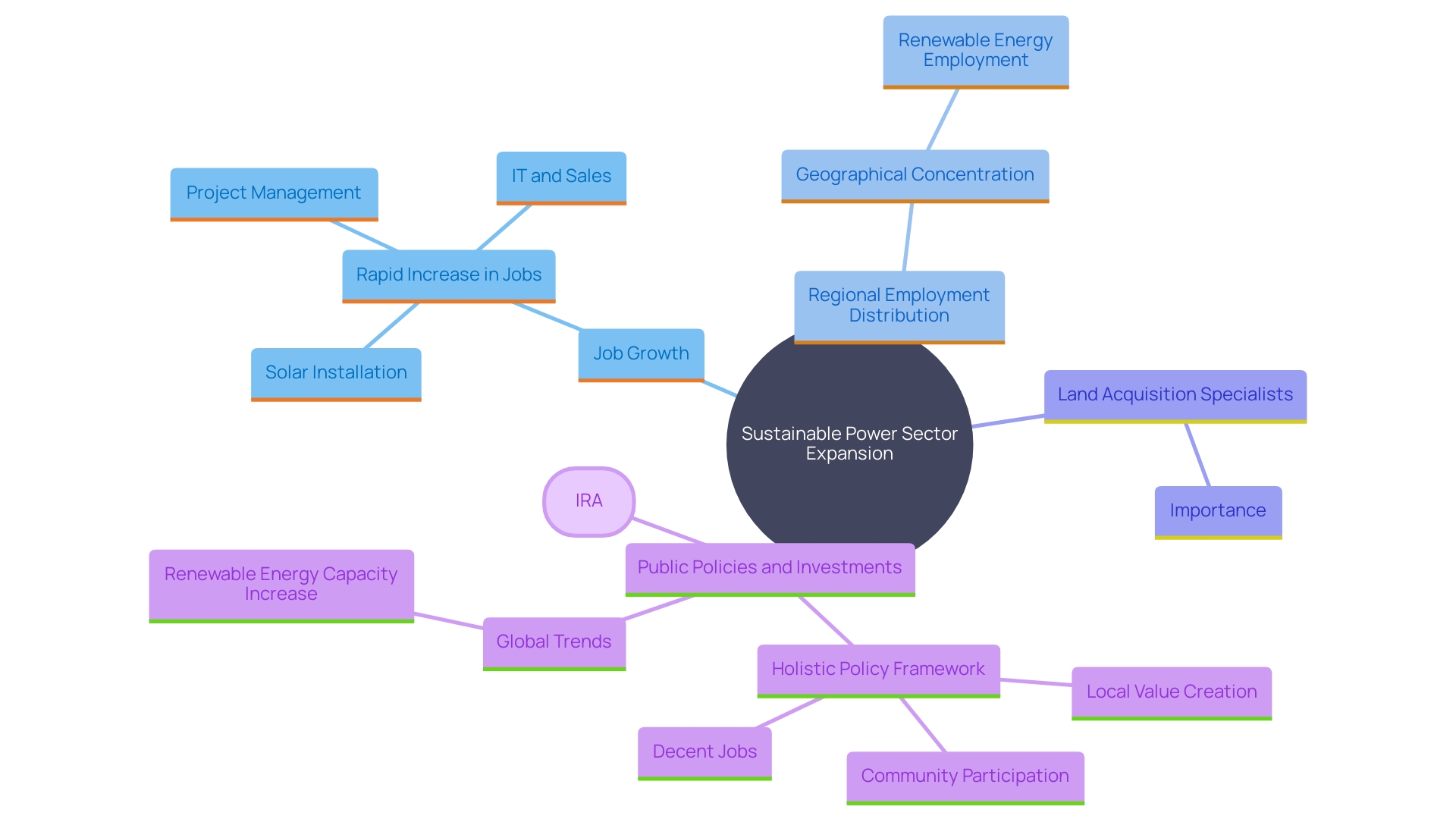
Key Roles in Renewable Energy Land Acquisition
Efficient land procurement for sustainable power initiatives necessitates a variety of specialized positions to tackle the intricacies involved. Project management specialists ensure that timelines and budgets are adhered to, which is crucial given the rapid growth in renewable resources. For instance, solar power alone represented 55% of new electricity-generating capacity in 2023, adding 40.3 GW in new capacity and creating thousands of jobs.
Legal negotiation experts play a pivotal role in navigating the intricate regulatory landscape. This is particularly important given the numerous disputes and legal challenges that can arise. For example, a wind initiative in southern France was dismantled due to noise pollution complaints and bird deaths. In the U.S., there have been 417 rejections or restrictions of wind energy initiatives since 2015, illustrating the legal hurdles that can impede renewable energy development.
'Environmental assessment specialists are essential for ensuring initiatives comply with environmental regulations and mitigate negative impacts.'. Collaboration between private sectors, government agencies, and local communities is crucial in identifying suitable land and addressing land tenure issues. 'This approach has been successful in large-scale initiatives like the solar park in Madhya Pradesh, India, where clustering solar production allowed for shared infrastructure benefits.'.
The need for sustainable power keeps increasing, propelled by efforts such as New York State’s aim to reach 70% sustainable sources by 2030. 'This growing need highlights the significance of having a diverse group of experts to handle property acquisition efficiently, guaranteeing that sustainable initiatives are both feasible and enduring.'.
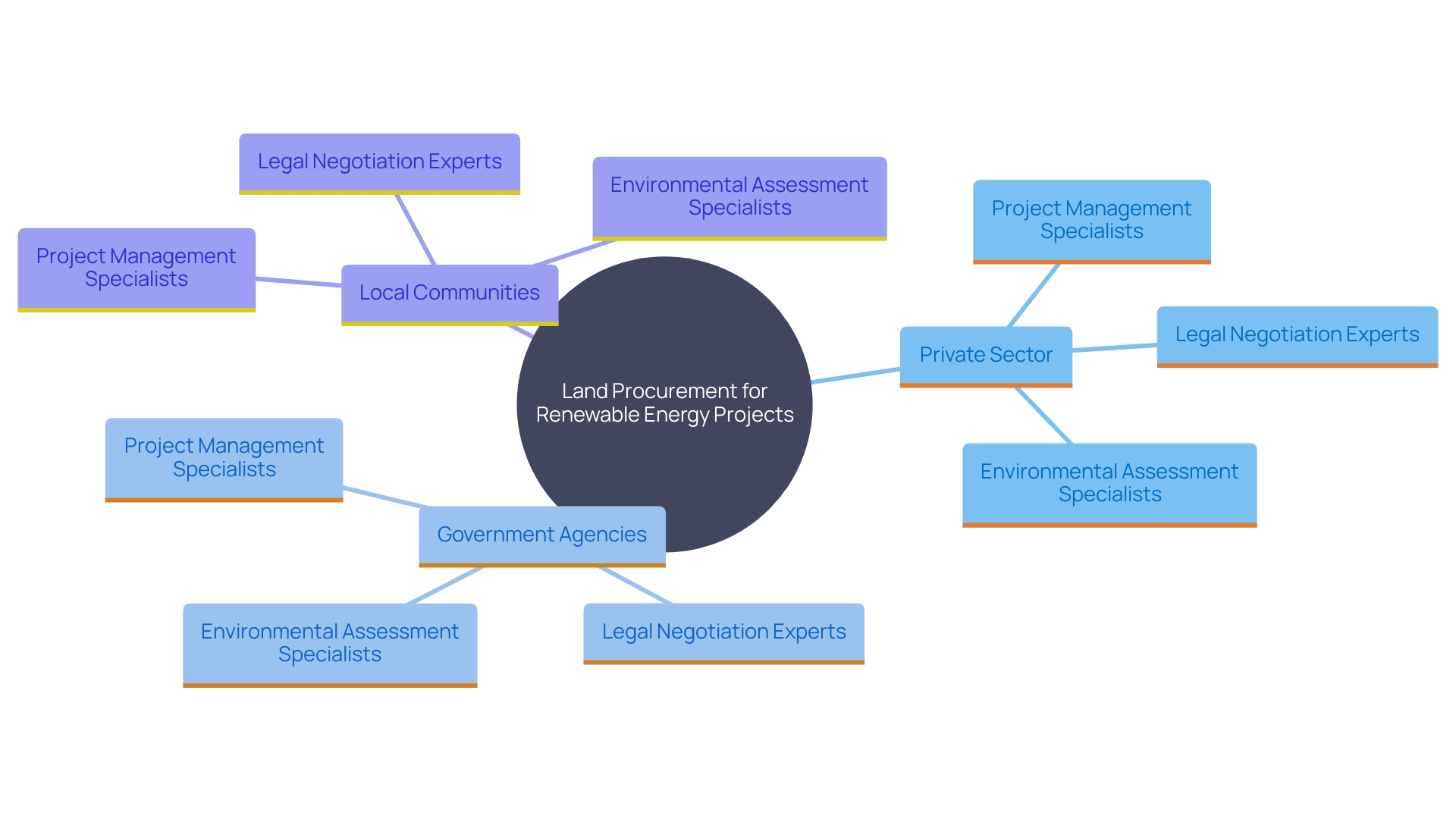
Renewable Energy Project Manager
Managers of initiatives play a crucial role in the successful implementation of renewable resources by coordinating teams, overseeing budgets, and ensuring compliance with regulatory standards. 'Their guidance is vital in maneuvering through the intricate terrain of property acquisition, a significant element for large-scale power initiatives.'. For instance, the Osage tribe's victory over Enel, which resulted in the removal of turbines and millions in damages, underscores the importance of compliance and community engagement. This situation emphasizes the increasing resistance to wind power in countryside regions, with comparable legal obstacles observed worldwide, such as the deconstruction of a wind initiative in southern France due to noise disturbance and avian fatalities.
The need for sustainable resources requires large areas, a challenge highlighted by India's method of grouping solar generation, facilitating shared infrastructure and effective use of space. This strategy not only facilitates investment but also addresses the need for significant private financing in climate adaptation, which is projected to reach as high as $390 billion this decade. Efficient property acquisition procedures enable both authorities and private entities to invest in renewable resources, transit-oriented development, and other infrastructure initiatives more broadly.
Collaboration among private entities, government agencies, and local communities is critical in identifying suitable land, resolving land tenure issues, and ensuring community participation. 'This method is clear in initiatives like the solar-plus-storage facility in El Salvador, which incorporates advanced battery technology to offer dependable, carbon-free power continuously, thereby changing local power distribution and improving community resilience.'.
Furthermore, the economic and social advantages of renewable initiatives are considerable, as demonstrated in Pennsylvania's BE Pines solar endeavor, which generated employment and economic development for a region historically dependent on fossil fuels. The growth of solar energy, which represented 55% of new electricity-generating capacity in 2023, further highlights the sector's swift expansion and potential for job creation, stressing the necessity for strategic leadership in management to handle these complex challenges effectively.
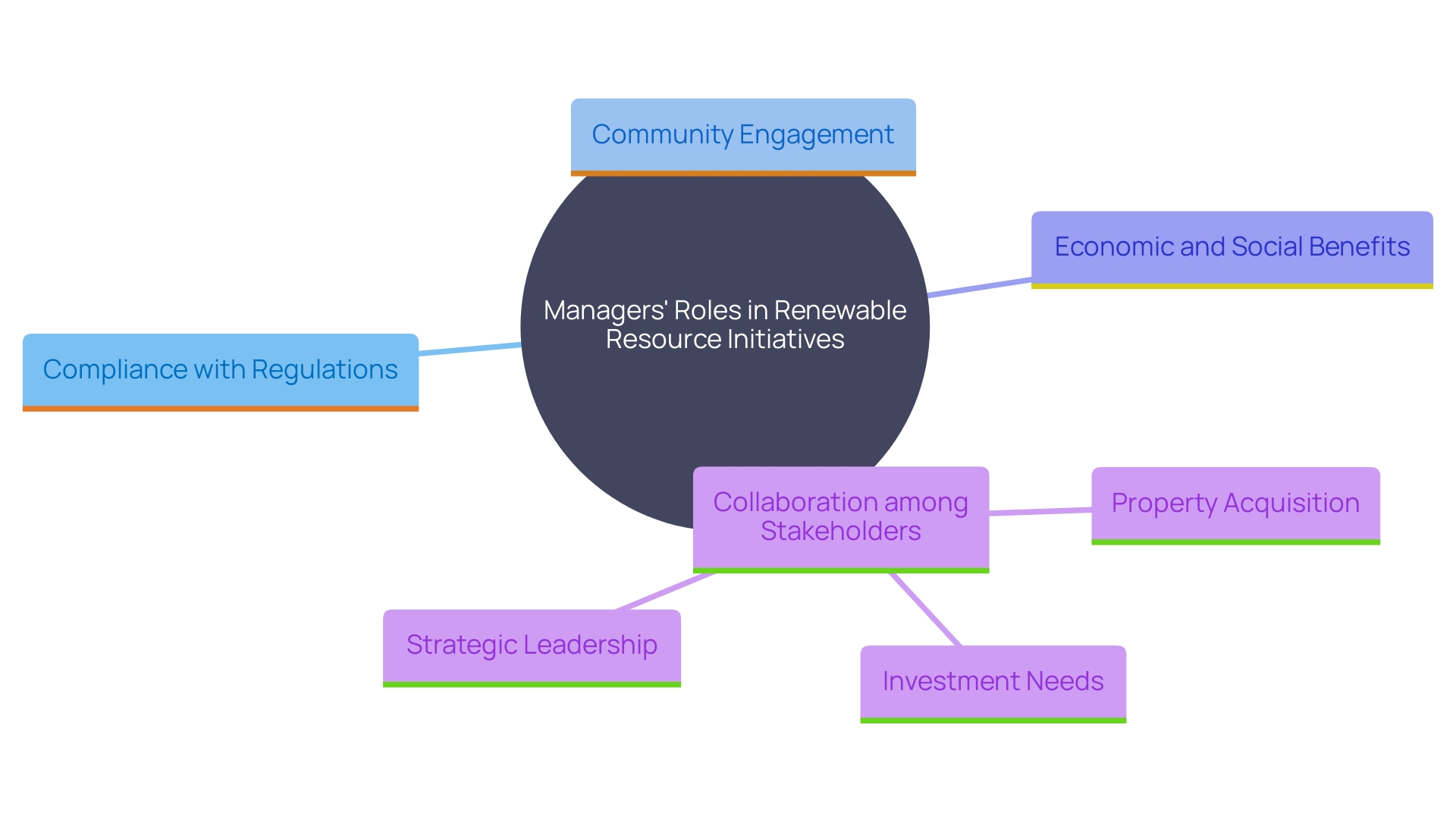
Solar Project Developer
Solar developers must meticulously identify suitable sites for solar farms, a process that involves evaluating land characteristics, engaging with landowners, and negotiating agreements. This comprehensive approach ensures that initiatives align with local regulations and community interests. However, this process can be fraught with challenges, as seen in the case of Kingwood Solar, where local opposition from Greene County and three townships led to the initiative's rejection. Despite agreeing to address 39 development conditions, the initiative's incompatibility with local zoning plans and potential negative economic impacts were significant concerns.
The importance of community engagement and adherence to local regulations cannot be overstated. For instance, the Birch Solar initiative faced similar opposition, with the Ohio Power Siting Board (OPSB) noting that approximately 80% of public comments were against it. This opposition was based on concerns about local territory use plans, economic impacts, and the rural character of the community. Despite offering 'good neighbor' payments and property value adjustments, the overwhelming local government opposition led to the project's rejection.
Furthermore, the growth of solar energy to achieve net-zero emissions by 2050 necessitates considerable space use, estimated at around 16,000 square miles or 0.5% of the U.S. territory. 'This large-scale use of terrain highlights the necessity of balancing environmental benefits with community impacts.'. As Kaitlyn Spangler from Penn State's Department of Agricultural Economics notes, understanding where this area is and how it affects local communities is crucial for sustainable development.
The complexity of regulations and the need for clear communication with stakeholders are paramount. Developers must navigate these challenges to ensure that initiatives not only comply with legal requirements but also gain community support. As Justin Lindemann from the NC Clean Energy Technology Center highlights, the duty for land restoration rests with the developer or owner, stressing the significance of planning for the entire lifecycle of the endeavor.
In conclusion, successful solar initiative development hinges on thorough site assessments, strategic negotiations, and robust community engagement. By addressing local issues and adhering to regulatory frameworks, developers can pave the way for sustainable and community-supported solar initiatives.
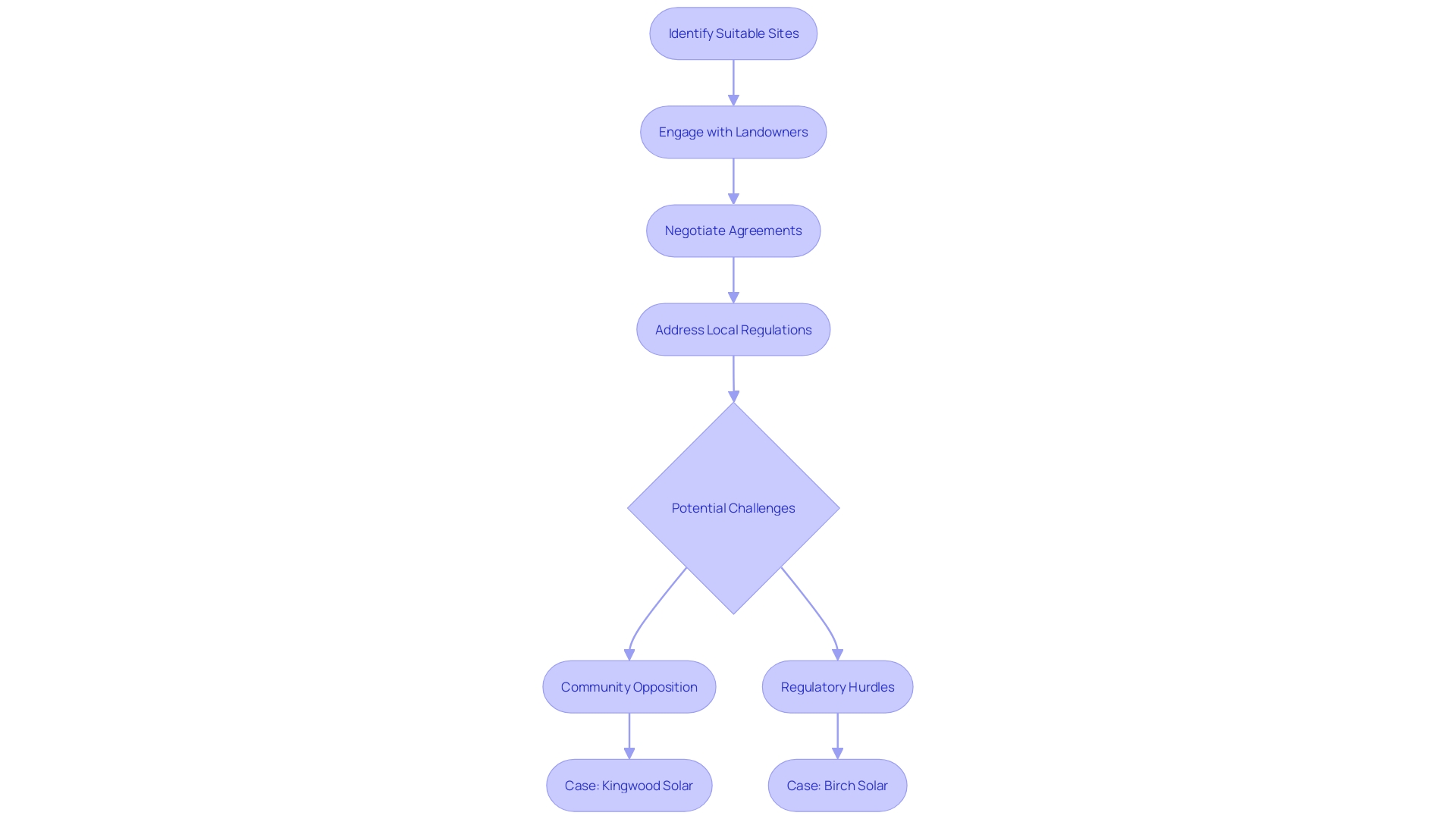
Land Acquisition Specialist
Land acquisition specialists play a crucial role in identifying and securing potential sites for sustainable energy projects. Their profound understanding of negotiation tactics and strict adherence to legal compliance are indispensable for successfully acquiring land. 'According to a survey by Transect, 86% of developers involved in sustainable energy faced delays of three months or more due to permits or regulations, highlighting the complexity and necessity of expert intervention in the acquisition process.'. Additionally, with 60% of developers noting it takes at least a month to receive a report back, the expertise of these specialists becomes even more critical.
The sustainable power industry is filled with difficulties, especially with the changing financial and regulatory environment. For instance, developers in Madagascar must navigate intricate customs and tax regulations to benefit from VAT exemptions on sustainable energy equipment and income tax reductions. The planned update and revision of Madagascar's customs and tax handbooks by SEforALL aim to provide developers with the clarity needed to leverage these incentives effectively.
These specialists also ensure that sustainable initiatives comply with all environmental and zoning regulations, thereby reducing risks associated with protected features. It’s reported that 30% of real estate transactions fall through due to unexpected protected features like endangered species, underscoring the importance of thorough due diligence. This meticulous approach not only facilitates smoother development but also aligns with broader conservation and community goals.
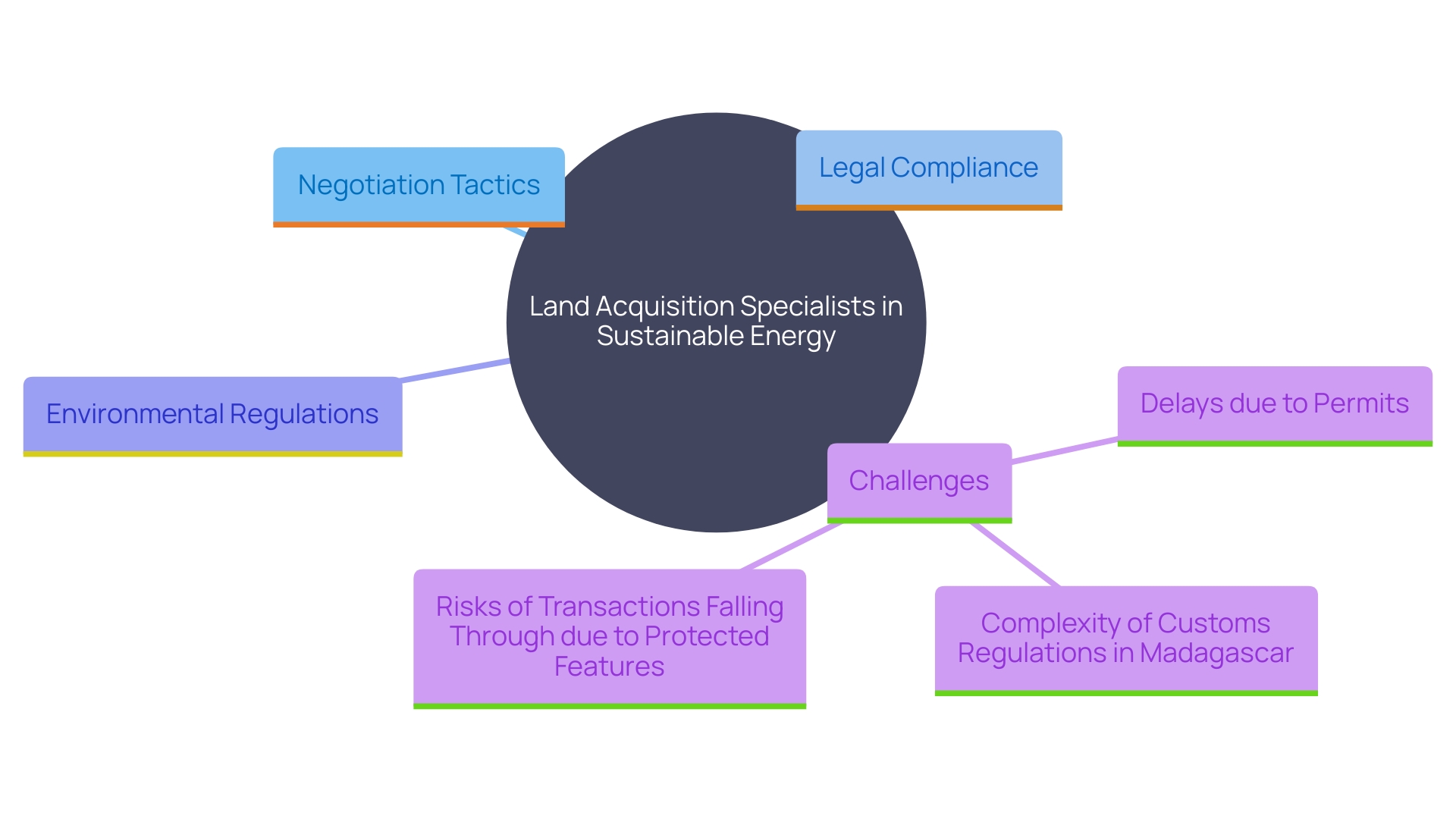
Environmental Engineer
Environmental engineers play an essential role in ensuring that land acquisitions for renewable resources adhere to environmental regulations and promote sustainable development. Their work involves conducting comprehensive environmental impact assessments (EIAs) to evaluate the potential ecological effects of energy initiatives. For instance, McManamay et al. (2020) developed eco-evidence tools that help identify environmental indicators needing further research and those potentially impacted by hydropower development. Such assessments enable early-stage identification of ecological risks and inform strategic planning to mitigate adverse effects.
'A notable example is the Navitta initiative in Antigua, Guatemala, where sustainability strategies were integrated into the design of a new shopping mall.'. 'The objective was to achieve Energy Net Zero and obtain a sustainability certification, demonstrating the significance of environmental considerations in development initiatives.'. 'The initiative pushed the boundaries of natural ventilation and lighting, highlighting the innovative approaches required to minimize ecological footprints.'.
Moreover, the collaboration between various stakeholders, including NGOs, academia, and industry, is essential in fostering sustainable solutions. For instance, Aruomah Emmanuel, an MSc Environmental Engineering student, highlighted the significance of multidisciplinary initiatives in preparing future engineers with the abilities required for environmental preservation and sustainable progress.
The growing availability of specialized technical assistance for clean initiatives, as enabled by platforms such as the one introduced by the World Bank and the Common Market for Eastern and Southern Africa, highlights the worldwide dedication to speeding up the shift to renewable sources. Such initiatives aim to fill technical knowledge gaps and support both public and private sectors in implementing environmentally responsible power solutions.
Wind Farm Site Manager
Site managers for wind farms play a crucial role in overseeing the daily operations of wind energy initiatives, including site acquisition. They guarantee that all facets of land management and execution adhere to local laws and regulations. Wind farm developments, such as those managed by Avangrid, can significantly impact local communities, providing jobs and supporting public services through property taxes. For instance, the construction at Osagrove Flats is expected to create about 300 jobs and contribute over $40 million in property taxes over the duration of the development.
However, the process of site acquisition and management is often fraught with challenges. The Osage tribe's victory over Enel, which involved the removal of turbines and significant financial penalties, highlights the complex legal and social issues that can arise. This situation is a demonstration of the growing resistance to wind initiatives from rural inhabitants worldwide. Since 2015, there have been 417 refusals or limitations of wind power initiatives in the United States alone, from Maine to Hawaii.
Additionally, the permitting process for wind energy initiatives can be complicated and lengthy. In 27 states, the authority to site and permit developments depends on their size, with larger endeavors often requiring state-level approval. Timelines for permitting vary widely, with some states taking as short as 30 days and others up to a year. Digitalization of the permitting processes, as proposed by the European Commission with the Wind Power Package, could streamline these procedures and reduce inefficiencies.
Overall, while wind farms provide significant advantages, site managers must navigate a complex landscape of legal, regulatory, and community challenges to ensure successful implementation.
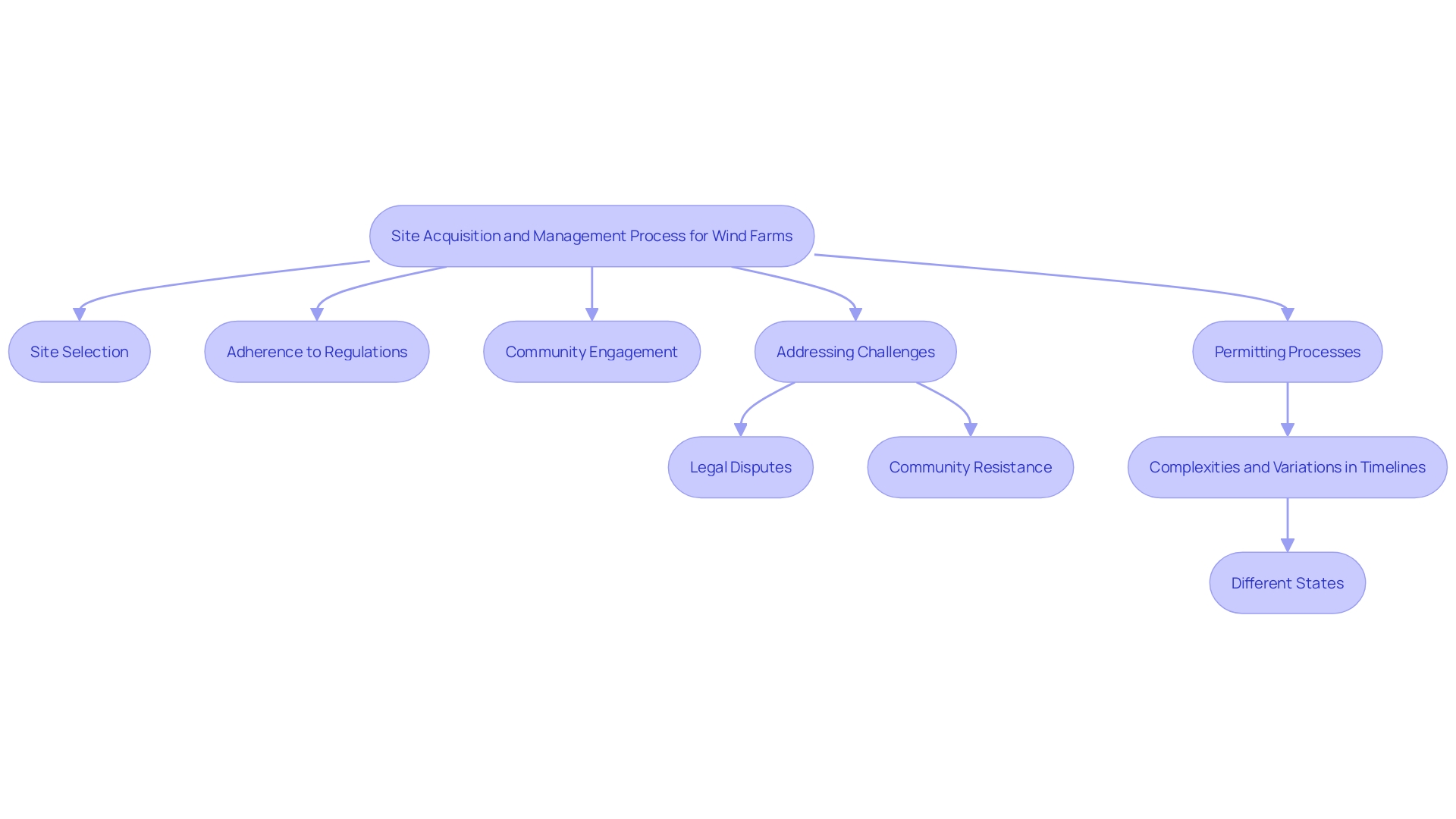
Skills and Qualifications for Renewable Energy Land Acquisition Careers
Experts in the sustainable power land procurement and administration sector generally possess expertise in environmental science, project oversight, or legal studies. Essential skills include the ability to articulate complex ecological issues to diverse audiences, demonstrated leadership, and strategic planning. Familiarity with legal and regulatory frameworks related to ecology and environmental impact assessments is crucial. Additionally, strong networking capabilities are necessary to build and maintain relationships with clients, regulatory bodies, and industry stakeholders. Relevant professional certifications, such as Chartered Ecologist status, are advantageous. Outstanding written and spoken communication abilities are essential, along with the capability to perform comprehensive site evaluations and maneuver through the complex framework of sustainable regulations.

Growth Projections and Salary Ranges in Renewable Energy
The sustainable power industry is on a strong growth trajectory, generating a rise in job openings and attractive salaries. 'In 2023, sustainable power positions surged from 13.7 million in 2022 to 16.2 million, indicating an 18% rise, as per the Sustainable Power and Jobs – Annual Review 2024 by the International Sustainable Power Agency (IRENA) and the International Labor Organization (ILO).'. This growth reflects the expanding capabilities in sustainable power generation and equipment manufacturing.
A closer look at the data reveals that over half of the employment growth was concentrated in solar photovoltaics, wind, electric vehicles (EVs) and batteries, heat pumps, and critical minerals mining. Solar PV alone accounted for 4 million jobs, making it the largest employer in the sector. 'The heightened demand for clean power technologies has propelled the necessity for a skilled workforce, with investments in education and training becoming essential to prepare workers for these new roles.'.
Experts in land acquisition within the renewable resources sector can anticipate diverse salary ranges based on their position and experience. The demand for skilled workers in this field is high, reflecting the broader trend of rising employment in clean power sectors. As the sector continues to expand, the need for a diverse and well-trained workforce will remain a top priority, ensuring that the energy transition is both just and inclusive.
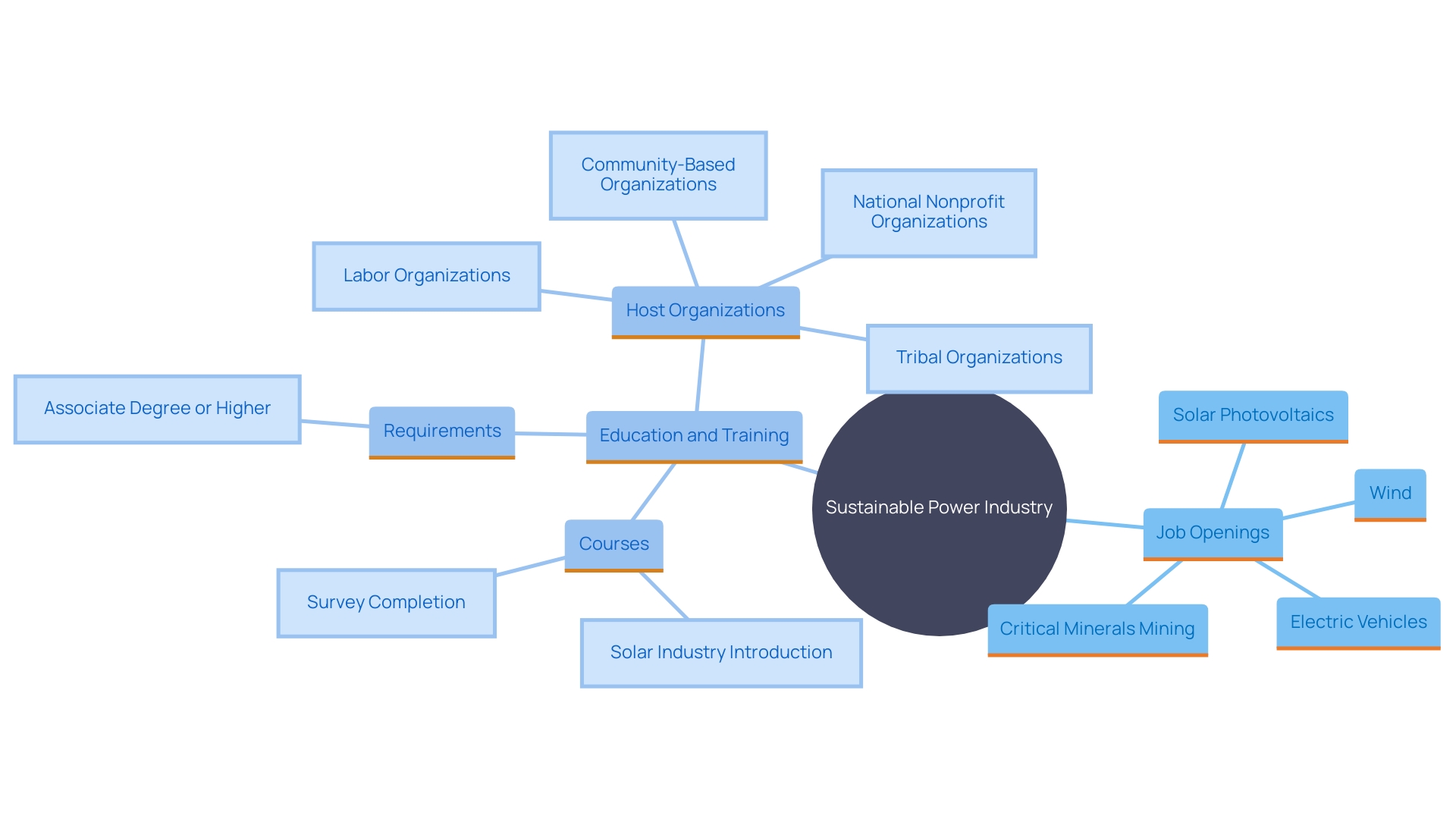
Conclusion
The renewable energy sector is undergoing a remarkable transformation, evidenced by the significant increase in job opportunities and the critical roles played by various professionals within the industry. The rise from 13.7 million jobs in 2022 to 16.2 million in 2023 highlights the urgent need for skilled labor to meet the demands of expanding clean energy technologies. Key sectors such as solar photovoltaics, wind energy, and electric vehicles are at the forefront of this growth, underscoring the importance of a diverse and well-trained workforce.
Land acquisition professionals are essential in navigating the complex landscape of regulations and stakeholder engagement necessary for successful project implementation. Their expertise is vital in securing suitable sites, ensuring compliance with environmental laws, and addressing community concerns. The challenges faced in land acquisition, such as legal disputes and public opposition, further emphasize the need for strategic management and collaboration among various stakeholders.
Looking ahead, the renewable energy job market is poised for continued expansion, with projections indicating the creation of millions of new positions. Public policies and significant investments are driving this momentum, reinforcing the need for ongoing education and training to prepare the workforce for future opportunities. The commitment to sustainable energy solutions not only promises economic benefits but also paves the way for a cleaner, more resilient future.




